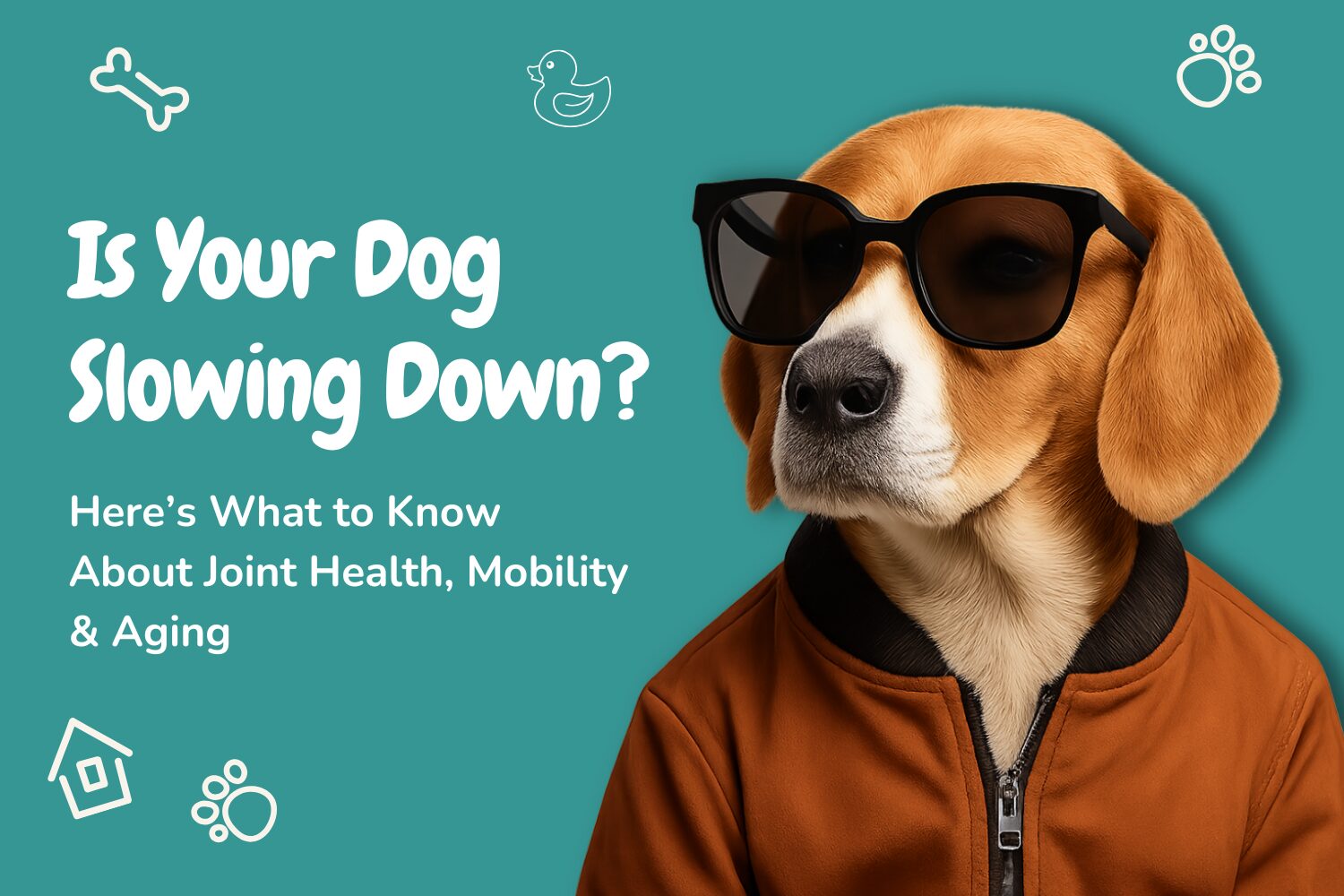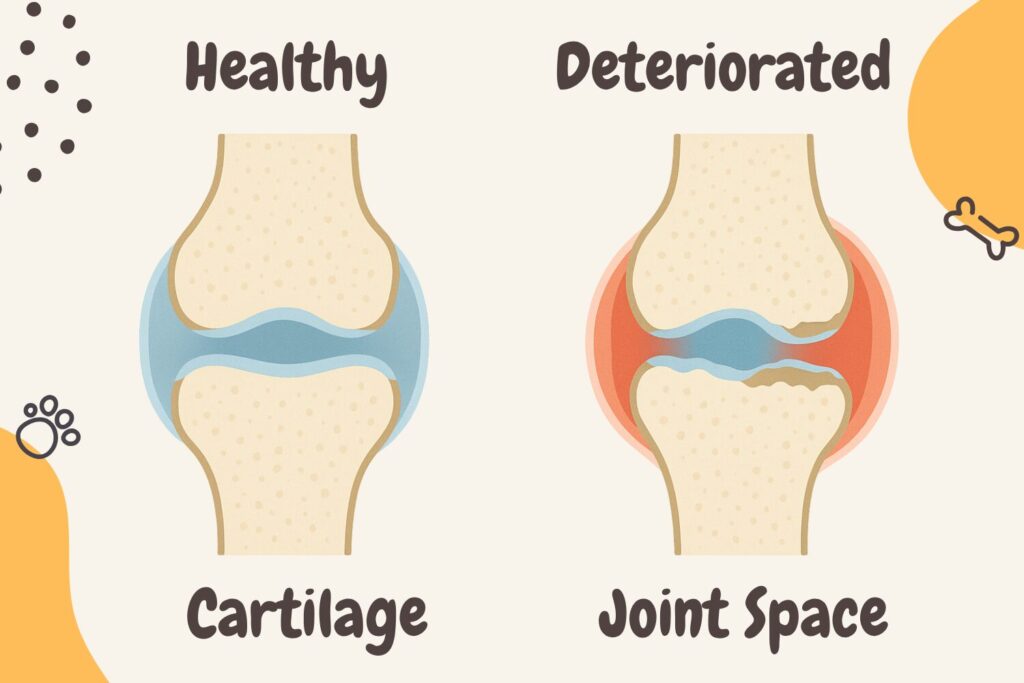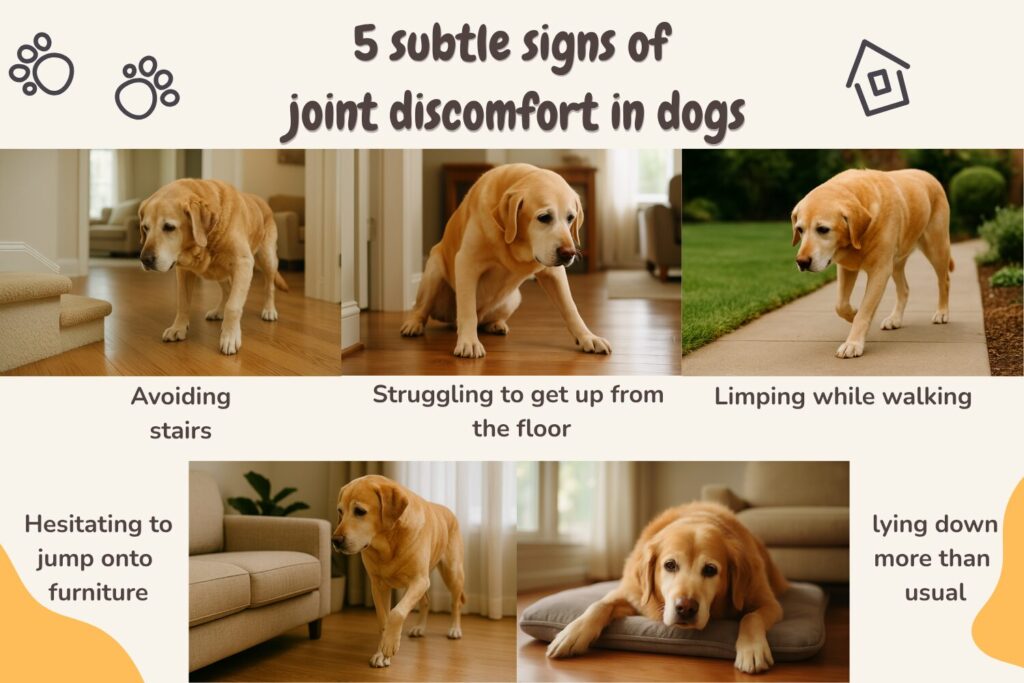Is Your Dog Slowing Down? Here’s What to Know About Joint Health, Mobility & Aging

Dogs are naturally energetic — they run, jump, chase, and greet you with boundless excitement. So when your once-active companion starts hesitating on walks, avoiding stairs, or showing signs of stiffness, it’s easy to wonder: Is my dog just getting older, or is something more going on?
In many cases, subtle changes in your dog’s movement can be early signs of joint wear, discomfort, or loss of mobility — especially in larger or aging breeds. But the good news? You can take simple steps to support your dog’s joint health, often long before symptoms get worse.
Why Do Dogs Slow Down as They Age?
Just like humans, a dog’s joints take on wear and tear over time. Cartilage — the cushion between bones — can begin to thin or break down. This makes movement less smooth and more painful.
Here are a few common reasons dogs slow down:
- Aging: Natural cartilage breakdown over the years
- Breed tendencies: Large breeds like Labradors, Golden Retrievers, and German Shepherds are more prone to joint issues
- Weight gain: Extra pounds put more strain on joints
- Arthritis or hip dysplasia: Inflammatory or genetic joint conditions
- Low activity levels: Less movement can actually stiffen joints further
Slowing down isn’t just “getting old” — it can be your dog’s way of adapting to discomfort.
How Dog Joints Actually Work?— And Why They Break Down

Every joint is made of bone, connective tissue, cartilage, and a fluid called synovial fluid that keeps everything moving smoothly. Over time:
- Cartilage thins out
- Fluid levels drop
- Inflammation rises
- Bones rub more directly, causing discomfort or stiffness
Even moderate joint wear can cause your dog to limit activity, lie down more, or seem “lazy” — when really, they’re adjusting to discomfort.
Early Signs of Joint Discomfort You Shouldn’t Ignore

Many dogs won’t yelp or limp — they’ll just change how they move. Look for:
- Slower walks or shorter play sessions
- Struggling to get up after rest
- Reluctance to climb stairs or jump into cars
- Favoring one leg or shifting weight awkwardly
- General stiffness in the morning or colder weather
These can be subtle signs of early-stage joint stress, and catching them early allows for better long-term care.
Lifestyle Tips to Support Healthy Joints

Before jumping into solutions, let’s talk about prevention. You can do a lot at home to keep your dog’s joints comfortable and supported:
Keep Their Weight in Check
Even a few extra kilos can drastically increase joint pressure. Stick to portion-controlled meals and regular light activity.
Gentle Daily Movement
Short, low-impact walks (avoid long hikes or jumping) keep joints from stiffening up. Swimming is excellent for dogs with joint concerns.
Create a Joint-Friendly Environment
Ramps over stairs, soft orthopedic beds, and traction mats (for slippery floors) can make a big difference — especially for senior dogs.
Supportive Nutrition
Including foods or supplements rich in:
- Omega-3 fatty acids
- Turmeric or Boswellia
- Green-lipped mussel extract
- Glucosamine & Chondroitin
These compounds are known to support cartilage health, ease stiffness, and reduce inflammation.
Should You Consider a Joint Support Supplement?
Supplements aren’t magic pills — but they can play a role in a long-term joint care plan, especially when combined with the right diet and lifestyle.
If you’re considering adding one:
- Look for ingredients like Glucosamine, Chondroitin, and herbal antioxidants
- Choose supplements free from heavy fillers or artificial preservatives
- Opt for formulas created specifically for dogs, with proper dosing and absorption
Glumaxx Joint Support, for example, combines Glucosamine, Chondroitin, Curcumin, and Boswellia Serrata — a natural blend used to support joint mobility and flexibility. While not a treatment, it may complement joint-friendly habits in active or aging dogs.
If your dog also needs calcium support, especially during bone growth or post-surgery, combining this with a calcium-focused product like GenextPet CAL can offer balanced bone + joint wellness.
When Should You Start Thinking About Joint Care?
Early is always better — and it’s not just about age.
You might consider joint care if your dog is:
- A large breed, over 20kg
- Naturally active or athletic (e.g., agility dogs)
- Senior (7+ years)
- Recovering from injury or surgery
- Showing early signs of stiffness
Even healthy dogs can benefit from proactive joint support — think of it like giving your dog a cushion against future wear and tear.
Also Read: How to Boost Energy in Senior Dogs Without Overexertion
Final Thoughts: Mobility Means Quality of Life
A dog’s ability to move freely is deeply tied to their happiness and well-being. If you notice subtle changes — slower walks, hesitation on stairs, reduced excitement during play — don’t ignore it. Joint care isn’t just about supplements or aging; it’s about giving your dog the comfort and energy to enjoy life.
Whether you focus on better exercise habits, smarter food choices, or gentle supplement support, you’re helping your dog stay active and pain-free for as long as possible. That’s a gift every pet deserves.
faq
Why do dogs slow down as they age?
Dogs slow down due to natural cartilage breakdown, breed-related joint issues, weight gain, arthritis, and reduced activity. These factors cause discomfort, leading to slower movement and reduced enthusiasm for physical activity.
What are the early signs of joint discomfort in dogs?
Early signs include reluctance to climb stairs, shorter play sessions, stiffness after rest, difficulty getting up, favoring one leg, and hesitating during walks. These subtle cues often indicate joint wear or discomfort.
How can I support my dog’s joint health at home?
Maintain a healthy weight, provide daily gentle movement, use ramps or orthopedic beds, and incorporate joint-supportive nutrition, including omega-3s, turmeric, and glucosamine-based supplements.
Should I give my dog a joint supplement?
Yes, joint supplements can help maintain mobility and reduce stiffness when combined with a healthy lifestyle. Look for products containing Glucosamine, Chondroitin, Boswellia, and other natural anti-inflammatory ingredients designed specifically for dogs.
When should I start joint care for my dog?
It’s best to start early, especially for large breeds, senior dogs, or dogs recovering from injury. Even young and healthy dogs benefit from proactive joint support to prevent future wear and maintain mobility.
About Author
Dr. Kevin Modi
Dr. Kevin Modi is a trusted voice in the Indian pet care space, with years of hands-on experience in pet wellness, gut health, and natural supplements. At GenextPet, he guides product formulation and ensures content accuracy, drawing from real-world insights and the latest research. His goal? To simplify pet health for every dog and cat parent.

